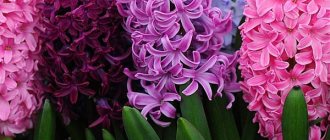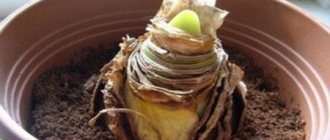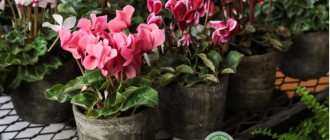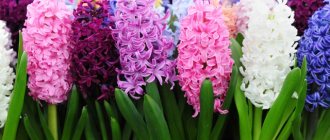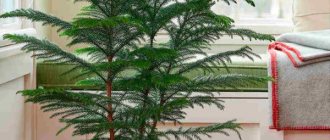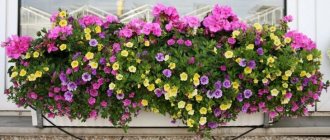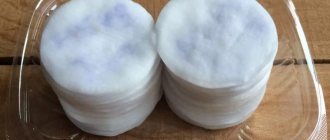Growing hyacinth is not a problem. It is much more difficult to achieve flowering by the desired date. We'll tell you how to make hyacinths bloom for the New Year, Valentine's Day or March 8th.
Hyacinth bulbs are used not only for planting in open ground, but also for forcing at home for the New Year, Valentine's Day and March 8th. Of course, you can not complicate your life and just buy your favorite flower in a pot on the eve of the holiday. But in fact, the process itself is quite simple. In addition, self-grown flowers will be cheaper. And the joy of seeing tender buds bloom cannot be compared with anything!
Hyacinths are easy to force. Even if you make a mistake, you are unlikely to ruin the bulbs. The worst thing that will happen is that flowering will occur earlier or later than planned, and the sultan-inflorescence itself will not stretch enough.
Forcing hyacinths in water
agardenforthehouse.com
Hyacinths can be grown not only in soil, but also in water. This method allows you to get a beautiful flower even faster. However, certain rules still need to be followed.
Firstly, it concerns capacity. It is desirable that this be a special vessel. But if you don’t have one, you can use a regular tall glass.
Secondly, you should not use tap water. It is better to replace it with melted one. Pour the liquid so that, after placing it on the edges of the glass, there is 1.5-2 cm between the bottom of the onion and the water.
Also place the bulbs for forcing hyacinths in water in a cool, dark place, for example, in the refrigerator, where they will spend several months until roots appear. Then move the hyacinth to a warmer place and cover with a cap. The cap can be removed only after the sprout appears.
How to choose a good, healthy plant in the store
Flowers bought in a hypermarket need special care, which is sometimes impossible to provide at home.
The success of growing hyacinth in a pot directly depends on the quality of the seed. In order to avoid mistakes, the following rules are recommended.
- For forcing, bulbs with a diameter of at least 50 mm are used. If hyacinths are to be grown in the garden, finer seeding material will be suitable.
- Depending on the variety, the maximum permissible diameter of bulbs for growing hyacinth in a pot is 40–60 mm.
Requirements for the appearance and quality of seed:
- absence of rot and mechanical damage;
- smooth surface;
- absence of traces of pests and diseases;
- structure that is hard to the touch.
Important! The main criterion for choosing hyacinth for growing in a pot is the ratio of the diameter of the bulb and its bottom. It should be 1.5–1.6:1. For unsuitable seed, this ratio is much lower.
Resuscitation of hyacinth bulbs after forcing
gardeningknowhow.com
Forcing greatly depletes the bulb. Therefore, after the hyacinths bloom, many people prefer to simply throw away the used planting material. But if you put in a little effort, the bulbs can be revived. To do this, follow our recommendations.
- Remove dried inflorescences.
- Fertilize the hyacinth once with fertilizer for bulbous plants.
- Raise the air temperature to 22-23°C and continue to light the flower and water it moderately for a week. This is necessary to activate the process of regeneration bud formation.
- After a week, reduce watering and leave only natural light.
- Stop watering completely when the leaves begin to yellow.
- Place the pots on their side to ensure better flow of nutrients from the green mass to the bulb.
- Remove the bulb from the soil after the leaves have completely died. Dry it and store it at 17°C until planting.
The largest bulbs can be used for re-forcing. But be prepared for the fact that the flowering will no longer be so lush. It is better to plant the hyacinth in the ground so that it can fully regain its strength.
Forcing hyacinths is one of those activities that, once you try it, you can’t stop. After all, their delicate or, on the contrary, bright inflorescences are a real spring miracle, which is so missed during the long winter months.
Diseases and pests
Like any other plant, this flower can be affected by various diseases and pests. The most common ones when growing hyacinths in pots are the following.
Yellow bacterial rot
When the disease occurs, the leaves of the plant are affected, and then the bulbs (orchid in the photo)
The disease is accompanied by liquefaction of the bulb, a pronounced unpleasant odor, and cessation of plant growth. At the initial stage of yellow rot infection, gray spots appear on the leaves.
Parasitic blossom end rot
The disease is caused by pathogenic microorganisms found in contaminated soil. Signs of the disease:
- brown small depressions on flowers and leaves;
- the tips of the leaves become covered with mycelium, become thinner and destroyed;
- the roots rot.
The decay process accelerates as the air temperature rises.
Mosaic
First the leaves wither, and then the whole plant.
Chaotically located elongated light green spots appear on the leaves and flowers. The affected areas begin to turn yellow and dry out. Plant growth slows down. Possible death.
Gray rot
Gray rot leads to the death of bulbs (pictured is a tulip bulb)
Most often it affects plants during the period of early growth. The disease is characterized by the formation of yellow spots, which gradually increase in size and acquire a brown color. The roots begin to rot quite quickly. The plant dies.
Pests
One of the parasites of hyacinths is tobacco thrips.
When grown outdoors, the most dangerous pests for hyacinths are aphids and thrips. They take sap from the plant, which leads to the drying of flowers and leaves. To prevent damage, spray with aphicides. The most effective are Fitoverm, Akarin, and Accord.
Plants grown in pots and outdoors may suffer from nematode damage. These parasites come in two types: stem and gall. Most often the former are found, parasitic on all parts of the plant, above-ground and underground. At the same time, the bulbs soften and hyacinth growth gradually stops.
There are no radical measures to combat these parasites. The only drug on sale that nematodes are sensitive to is Fitoverm. It is used as a therapeutic and prophylactic agent. Before planting, sprinkle the powder of this preparation on the soil in a thin layer and mix it with the soil to a depth of at least 15 cm.
Possible problems when growing hyacinths: table
A novice gardener will be helped by a table of possible mistakes when growing hyacinths in a pot and how to correct them.
| Problem | Cause | Solution |
| Increase in green mass in the absence of flowering | small onion | Select a bulb with a diameter of at least 5 cm and plant it |
| Different flowering periods for plants of the same variety when planting several bulbs at the same time in one pot | All bulbs planted in one container should be approximately the same diameter | Choose bulbs with a diameter of at least 5 cm |
| Slow growth, poor flowering | The “cold” period was not maintained before planting the bulb; the pot is moved to a warm place before the first shoots appear | Properly prepare a new bulb for planting, following the instructions above. |
| Deformed or missing flowers | The temperature during the “cold” period was above +9°C | Properly prepare a new bulb for planting |
| Yellowing of leaves, slow growth | Insufficient watering, poor lighting | Water the plant in a timely manner, move the pot to a well-lit place |
| Falling buds, rotting of the bulb | Excessive watering with water entering the leaf axils and buds | Water the plant at the root, at the edge of the pot |
How to grow hyacinths at home on March 8
Growing hyacinths by March 8 requires strict adherence to proven algorithms. It is necessary to care for flowers so that they bloom no later, but not earlier than the desired date.
Growing conditions
Planting for forcing is usually carried out in containers with a side height of 10-18 cm or directly in separate pots. Drainage holes are made at the bottom to remove moisture, and the containers are scalded with boiling water to disinfect them from bacteria.
The soil for planting the crop needs to be light and loose. You can use universal purchased soil from a gardening store or a mixture prepared by yourself. In the latter case, it is necessary to combine garden soil, turf and sand in equal proportions and add a little peat. Like the container, the soil must be disinfected. You can use a weak manganese solution or the drug Fitosporin.
Preparing the bulbs
To drive out hyacinths by March 8, you need to use only healthy and large planting material. The diameter of the bulbs should reach about 5 cm or more. You need to make sure that there are no dark spots or dots, rotten areas or other damage on their surface.
It is best to purchase bulbs in the fall that are specially marked “for forcing.” Until February, they can simply be left in a dry place at a temperature of about 17 °C. Preliminary stratification is not required for such material.
If you are going to use bulbs that you dug up in the garden yourself for planting, then after removing them from the soil they need to be kept at a temperature of 25-28 ° C for two months so that they dry out properly before forcing.
Planting hyacinths at home on March 8
To plant hyacinths at home by March 8, you need to follow a simple algorithm:
- In early November, drainage - coarse sand, pebbles or broken bricks - is poured into a wide container for seedlings or an individual pot about 15 cm high.
- Light fertile soil is laid on top in a layer of 4-5 cm.
- Add sand to the container again.
- Lightly compact the substrate and water generously.
- Install the bulbs at small intervals - they should not touch.
- Cover the planting material about 2/3 with soil, leaving the tops open.
There is no need to water the soil in containers with hyacinths. The seedling box is transferred to a dark place with a temperature of 4-6 ° C for three months after planting - in such conditions the bulbs will develop roots. You can place the container in the refrigerator on the bottom shelf or in a cool basement with low humidity.
After planting, the container with hyacinths should not be covered with film, as the bulbs may rot due to humidity.
Aftercare
About 12 weeks after planting, the hyacinth bulbs should produce their first green leaves. When the latter reach a height of 4-5 cm, you will need to remove the container from the refrigerator or basement and move it to a room with a temperature of about 13 ° C.
To force hyacinths out of the dark, you cannot immediately move them to bright light - the plants will experience severe stress. For the first ten days, keep the container in the shade; if necessary, put paper caps on the germinating bulbs. Then the amount of light gradually begins to increase, and the temperature also increases. But the shading is completely removed only after 20-28 days. The flower stalks should reach a height of about 15 cm by this time.
Caring for hyacinths after planting and before budding comes down mainly to watering. You need to moisten the soil in containers or pots regularly, but with caution, trying not to flood the plants. The room temperature should be approximately 20 °C. Plants that are ready to bloom are protected from drafts and direct rays of the sun.
Hyacinths during forcing by March 8 should be kept away from heating appliances
If hyacinths produce buds ahead of schedule, they must be moved to a shaded place and the temperature in the room reduced. And, conversely, to speed up the growing season, the crop is provided with more sunlight and heat so that the flowers bloom no later than March 8th.
Attention! After forcing the hyacinth bulbs into the substrate, at the end of the decorative period, they are dug up and dried, and in the fall they are planted again in the ground.
Choosing a place to grow hyacinths
The place chosen for planting hyacinths should be sunny and quiet. Hyacinths will feel great behind a hedge of shrubs or trees. Hyacinths do not like stagnant water, so this requirement must be taken into account when choosing a place to grow these flowers; if moisture collects and stagnates, the flowers will soon begin to rot, and it will not be possible to save the bulb. To prevent hyacinths from experiencing a lack of useful substances, do not plant them close to trees; firstly, in shaded areas, hyacinths do not develop inflorescences well and stretch upward, and secondly, they simply will lack useful microelements. It is better to choose areas with a slight slope so that the water flows out independently.
Spring care for hyacinths
With the onset of persistent cold weather, cover the area with planted hyacinths. To do this, you can use dry peat, humus, dry fallen leaves or spruce branches. In the spring, as soon as the soil begins to thaw, remove the cover, since hyacinths sprout very early. When planting late (October - November), insulate the area in advance and, after planting the bulbs, put back the removed covering material.
In the spring, at the beginning of the growing season and when buds appear, the plants are fed with complete mineral fertilizer. In dry weather, water regularly.
In case of frost, it is advisable to cover hyacinths with one layer of lutrasil.
Keep an eye on the sprouted bulbs: dig up diseased plants and unsprouted bulbs. You can tell which bulbs need to be removed when a few leaves appear: you can easily spot empty spaces or see signs of disease on fresh leaves. Watering hyacinths should be completed immediately after flowering; the bulbs are most afraid of soaking.
Hyacinth scent
Hyacinths have a very strong aroma and are actively used in the cosmetics and perfume industries. This component is considered an indicator that the perfume belongs to the highest class. The delicate and sonorous aroma is most often used when creating floral and oriental compositions. Some researchers claim that the scent of hyacinth helps relieve stress and improves performance. Dried hyacinth petals are placed in linen bags and used to arrange bed linen in the closet - it retains freshness for a long time.
Illustrations for the material: Shutterstock/TASS, Olga Petina
Step-by-step instructions for planting hyacinths in the fall
The secret to successfully planting hyacinths in the fall is very simple - you need to correctly perform not only the procedure itself, but also properly prepare the area for the future flower bed and the bulbs themselves.
Where is the best place to plant hyacinths: choosing a place
The more suitable area you choose for growing a bulbous crop, the more beautiful and magnificent the flowering will be. The following tips will help you choose the most suitable place for planting hyacinths in the fall:
- The heat-loving culture prefers sunny, warm areas that are well lit during the day.
- The place should be protected from winds, especially from the north.
- The plant does not tolerate stagnant water, so it is necessary to avoid lowlands, waterlogged areas, places with high groundwater levels or stagnant moisture after precipitation.
- The place should be level, or even better, with a slight slope, so that water after rain or melting snow immediately drains and does not accumulate next to the bulbs.
- It is not recommended to plant hyacinths too close to trees and shrubs, and now more in their tree trunks. Otherwise, the flowers will lack nutrients or be shaded.
- The ideal soil is fertile, light, loose, well-drained, moisture-permeable soil.
- The soil on the site must have a neutral reaction; the plant does not tolerate acidic soils.
Under no circumstances should hyacinths be planted in areas with waterlogging, otherwise the bulbs will begin to rot, become sick, and can easily die. You should also avoid heavy clay soils, but if such soil is everywhere in your garden plot, then you need to take measures to improve the quality of the soil, more on that below.
How to prepare the soil before planting
You need to start preparing the soil in advance, about 1-2 months before planting hyacinths in open ground, so that the soil has time to settle. Or at least 2-3 weeks in advance. If you do this shortly before the event, the earth will settle along with the bulbs, and the resulting roots will break off.
You can prepare the soil on your site using the following algorithm:
- First of all, you should dig the area to a depth of about 40-50 centimeters.
- To increase soil fertility, you can add organic and mineral fertilizers . As organic matter: compost or humus (1-1.5 buckets per square meter). As mineral fertilizers: superphosphate (60 g per sq.m.) and potassium sulfate (30 g per sq.m.), magnesium sulfate (15 g per sq.m.).
- Further preparation actions depend on the characteristics of the soil on your site (in addition to applying fertilizers): If the soil is heavy, clayey , then you need to add river sand (1 bucket per square meter) and preferably lowland peat (1 bucket per sq.m.) .
- If the soil is excessively light or sandy, then you should add lowland peat or turf soil, or leaf humus (1 bucket per sq.m.).
- If the soil is acidic (pH below 6.5), then you need to deoxidize the soil. To do this, you can use a special deoxidizer (according to the instructions), you can buy it at the garden center. Or use, for example, dolomite flour (at pH below 4.5 - 500 grams per square meter, at pH 4.5-5.2 - 400 g, pH 5.2-6 - 300 g).
Note! If the groundwater in your area is too high (above 50 centimeters from the surface of the earth), then you must make good drainage or make a high bed.
Preparing bulbs for planting
Before planting in the fall, you need to prepare hyacinth bulbs. First of all, carefully examine them; specimens affected by diseases must be immediately discarded. It is not recommended to plant them because they will infect healthy bulbs.
Also, to prepare hyacinth bulbs for planting, it is recommended to treat them by soaking them in a fungicide solution , for example, you can use “Maxim Dachnik”, “Fundazol”. Soaking will help eliminate pathogens and increase immunity against diseases.
Important! The fungicide solution should be prepared and treated strictly according to the instructions for the product!
Direct landing
To properly plant hyacinth bulbs in open ground in the fall, you need to follow the planting pattern:
- The first step is to make holes. But before you get down to business, you should know at what depth and at what distance to plant hyacinth bulbs: The depth is determined by the height of the bulb - you need to multiply the height by 3 (for example, if the height of the bulb is 4 cm, then you need to multiply 4 by 3, it turns out 12 , this is the depth of the hole). However, with light soil you can add 2 cm, and with heavy soil, on the contrary, reduce the depth of the hole by 2 cm.
- The distance between the holes for planting bulbs is 15 centimeters from each other. If the bulbs are small, the distance can be reduced to 10 cm.
- The distance between rows is about 20 cm.
Advice! If you have many bulbs of the same size, then instead of single holes, you can make one common trench or pit and place the bulbs in them at the optimal distance.
- Pour river sand onto the bottom of the hole or groove, the layer thickness is about 3-5 centimeters.
Advice! If you did not add fertilizer to the soil in advance, it is recommended to make the hole 3 cm deeper, and put three centimeters of compost or humus at the bottom of the hole, and then a layer of sand.
- Place the onion in the hole on the sand down , sprout up. There is no need to press it into the sand, just place it straight!
- Cover the bulb first with sand, and then with ordinary soil. The “sandy jacket” will prevent the onion from rotting, reduce the likelihood of disease, and improve drainage.
- After planting hyacinth, water to improve soil contact with the bulb and for faster rooting. If the soil is wet and the weather is damp and rain is expected, then you don’t have to water at all.
Advice! If you have a high groundwater table or heavy, clay soil, then it is better to make the ridges about 20 centimeters high. Moisture will definitely not accumulate on them, they will warm up better. They also have better moisture and air exchange.
Planting material for forcing
Bulb selection
For forcing, it is better to take large, mature and dense bulbs grown not in a greenhouse, but in open ground. The bulb must be free of mechanical damage, signs of disease, traces of the presence of pests and have a decent weight. If you decide to purchase hyacinth bulbs for forcing at a flower shop, then it is better to do this in September, and choose sizes 18/19, 17/18, and even better - 19+. Small bulbs will also produce flowers, but their inflorescences will not be as dense and elegant.
You can also use your own planting material for forcing. It must be selected according to the same principle: preference is given to the largest, full-bodied bulbs without signs of damage or ill health. However, if store-bought bulbs only need to be properly stored until planting, then your own bulbs require preliminary preparation, consisting of several stages, before forcing.
Read also about forcing crocuses at home
Almost all varieties of hyacinths are suitable for late forcing, but for early forcing it is better to take bulbs of the following varieties:
- Delph Blue;
- Gran Lila;
- Ostara;
- Anna Maria;
- Innossis;
- Bismarck;
- Amsterdam;
- Jan Bos;
- Eros.
Storing bulbs before planting for forcing
It is not advisable to plant hyacinths for forcing before September: after spring flowering they need time to recover, otherwise the bulb will not produce a good peduncle, the flowers will be small and the inflorescences will be loose. Dig the bulbs out of the ground as soon as the hyacinth leaves turn yellow, lie down and dry out, but do not try to speed up the process by cutting off the fading greens: the hyacinth leaves should fall off on their own.
Let the bulb dry, clean it from the soil and store it for the first time at a temperature of 30-33 ºC in dry peat, protected from direct sunlight. At this temperature, flower buds are formed in the bulbs. After 2 weeks, the temperature is gradually lowered to 22-25 ºC and the bulbs are kept in such conditions for about 3 weeks, and about a month before planting, the temperature is lowered to 17-20 ºC. The room in which planting material is stored should be regularly ventilated. In addition, from time to time you need to review the bulbs in order to promptly remove spoiled, soft or pest-infested specimens.
If during storage some of the bulbs have become slightly moldy, remove this plaque from them and dip the planting material in the Fitosporin-M solution for an hour, and then dry thoroughly.
How to regulate the speed of peduncle development
If you understand that the hyacinth will not bloom by the date you have determined, you can speed up the process by adjusting the temperature and lighting: the temperature is increased by 2-3 degrees, daylight hours are increased to 12-16 hours. You can slow down the development of the inflorescence by using the opposite measures: shortening the daylight hours or moving the flower to partial shade, while simultaneously lowering the room temperature by a couple of degrees. In cool conditions, hyacinth flowering lasts up to two weeks, and if the peduncle becomes very elongated, it is tied to a peg stuck next to the bulb.
Biological features and specifics of reproduction
The hyacinth bulb consists of a bottom, which is a shortened part of the stem, and storage scales surrounding it - modified lower leaves. When the plant “wakes up” in the spring, it grows an above-ground part: several narrow green leaves and a continuation of the bottom - a stem-peduncle on which buds develop. After flowering ends, the stem withers, and buds are laid in the axils of the scales, from which new bulbs (“babies”) are formed. With proper care in open ground, the bulb can bloom annually up to the age of 10 years.
Hyacinths are propagated mainly vegetatively, using daughter bulbs
Many varieties produce seeds, but only those gardeners who are seriously interested in varietal cultivation of the crop are sowing them.
Most summer residents renew their flower beds using “children” obtained from their own plants. An adult (over 3 years old) bulb can produce no more than 4 “offsprings” per season (usually 2-3 pieces). After digging up the “mother,” they try to separate each such “baby” from her, but this is not always possible. In the fall, the “young growth” is planted in a specially prepared garden bed, where it grows for 2-3 years.
If necessary (for example, for the purpose of propagating a rare variety), the amount of planting material can be increased. To do this, the bottom of a healthy adult bulb is cut out completely, or cross-shaped cuts are made on it.
Hyacinth bulbs contain large amounts of oxalic acid, which can cause skin irritation. Therefore, it is recommended to wear gloves when working with planting material.
Forced propagation techniques used in industrial floriculture make it possible to obtain up to 20-40 “children” from the mother bulb (by cutting out the bottom)
The sections are powdered with activated carbon and dried. Then the bulbs are placed cut side up in a box with a layer of coal, sand or perlite at the bottom. The container is placed in a plastic bag, which is tied and left in a warm place for about 2.5 months, during which “babies” form on the cuts. Then the mother bulbs are planted briefly in boxes with soil so that the “baby” gets stronger. All work must be completed by the beginning of September, since the “babies” must be separated, kept for 2 weeks in a cool, dry place, and sent to school before October.
When to plant hyacinths by March 8
It is quite possible to force hyacinths by March 8, but for this you need to adhere to optimal deadlines. First of all, plants require cold treatment, or stratification, for three months. After this comes the turn of planting, and flowering begins a couple of weeks after the formation of seedlings.
Thus, to force hyacinths out for the spring holiday, you need to start germination in mid or late November. Then the flowers will have time to harden properly, and after being transferred to the ground they will quickly sprout.
Recommendations and common mistakes
In general, forcing crops for the spring holiday does not present any particular difficulties. But inexperienced gardeners may encounter several problems:
- Lack of flowers. If hyacinths develop after planting but never produce buds, the reason is usually poor-quality plant material. Bulbs for forcing should be large, dense, without signs of damage by fungi and pests.
- Falling buds. If hyacinths are ready to bloom but then wilt, the problem is most likely due to irregular or excessive watering.
- Yellowing of leaves. The cause is usually drafts or lack of sunlight, as well as waterlogging.
- Peduncle too short. If the stem is weak and low, unable to rise above the leaves, this indicates insufficient stratification of the planting material in the cold.
If you are going to germinate the crop from bulbs you collected yourself, in the summer after digging them up, you need to keep them at a temperature of about 28 ° C for several weeks. Planting material is not immediately removed for storage. In this case, the bulbs will not dry out and will not form the embryo of a new flower.
When forcing by March 8, shortly before flowering, hyacinths should be watered so that water does not fall on the green parts
Popular varieties of hyacinths
The number of varieties of hyacinths is in the thousands; they differ in the height of the peduncle, the size of the inflorescences, color and flowering time (early, middle and late). However, the varieties differ little in height, flowering time and size. Therefore, the main feature for choosing hyacinths is the shade of the inflorescence.
White hyacinths
Aiolos, Edelweiss, Arentine Arendsen, Antarctica, Avalanche, Carnegie, l'Innocence, Louvre, Madame Sophie (terry), Polar Giant, Top White, White King.
Pink hyacinths
Anna Marie, Anna Liza, Apricot Passion, Apricot Star, Bestseller, China Pink, Double Eros (terry), Fondant, Freestyler, Ibis, Lady Derby, Marconi, Pink Pearl, Prince of Love (terry), Prince Rose.
Purple and crimson hyacinths
Jan Bos, Miss Saigon, Purple Star, Purple Voice, Splendid Cornelia, Showmaster, Woodstock.
Blue and lilac hyacinths
All Star, Aqua, Blue Giant, Blue Tango (terry), Blue Eyes, Delft Blue, Caribbean Dream, City of Bradford, Chicago, General Kohler (terry), Fresco, Koh-I-Noor, Top Hit, Sky Jacket.
Purple hyacinths
Atlantic, Aida, Blue Troph, Dark Dimension (almost black), Discovery, Manhattan (terry), Ocean Delight, Pacific Ocean, Purple Sensation.
Yellow hyacinths
City of Haarlem, Gipsy Princess, Yellow Queen.
There are new products: super-double orange hyacinths, as well as “multi-color” varieties, the color of each flower consisting of several colors. Such varieties have already been presented at exhibitions in Holland.
Watering and fertilizing
In winter and spring, you need to carefully ensure that the substrate does not dry out during forcing, otherwise the growing roots will lift the bulb and roll it to one side. Therefore, watering is needed regularly and in small portions. When the plant enters the dormant stage, it is practically reduced to a minimum. A wilted plant is not watered at all.
Feeding hyacinth is carried out systematically. For plants whose bulbs are at the dormant stage, slightly dissolved phosphorus-potassium fertilizers are required.
During flowering, compositions are used to feed the plant, with the help of which they stimulate the plant.
The most suitable varieties
To force buds by a certain date at home, you need to choose the right varieties according to flowering dates : early - on New Year and Christmas, medium - on Valentine's Day, late - on March 8.
A discrepancy between the expected forcing date and the flowering time of a particular variety will lead to an unfortunate result. The result will be a frail peduncle with unsightly inflorescences, but surrounded by lush, green leaves.
Early flowering
The natural flowering period of early varieties is March. Acceleration of the ripening process shifts the release of the flowering stem to December-January. The best early varieties are :
- Anna Marie;
- Amsterdam;
- Blue Magic;
- Bismarck;
- General;
- Gran Lila;
- Color;
- Delft Blue;
- Ostara;
- Pink Pearl;
- Innocent;
- Marconi;
- Eros;
- Jan Bos;
- Fondant.
This is interesting ! The first successful forcing of hyacinths at the end of December was carried out by the Dutch gardener Dames in 1909. Since 1924, scientists Blau and Leiten have studied the effect of temperature on hyacinth bulbs and provided a scientific basis for the forcing process. The USSR Academy of Sciences has paid attention to industrial forcing of bulbous plants since 1972.
Average
Medium-season hyacinths bloom in open ground closer to mid/late April. You can get fragrant inflorescences by February at home from the following varieties :
- Queen of Blues;
- Amethyst;
- Tubergen Scarlet;
- Gypsy Queen;
- Blue Sky;
- Lady Derby;
- Blue Jacket;
- Orange Bowen.
The Tubergen's Scarlet variety was bred in 1920 by the Dutch breeder I. Hug , named after the heroine of the novel Margaret Mitchell. The color of the terry petals is carmine-scarlet. This mysterious term refers to a rich, fiery red, ruby color.
Late
In nature, late hyacinths bloom in May, but at home you can stimulate the formation of their flower stalks by March. Suitable for forcing for Women's Day:
- Madame Haubensack;
- Snow Crystal;
- Woodstock;
- City of Harlem;
- Anna Lisa;
- Hollyhock;
- Gertrude.
Note ! Hollyhock is one of the latest varieties; it has bright crimson, double, large flowers. The flowering period reaches 20 days at a temperature not higher than 10-15oC.
Which varieties are best to use for forcing?
For planting by March 8, it is recommended to take hyacinths with early and medium flowering periods. Several varieties are most popular:
- Marconi. Hyacinth with early flowering grows to an average height of 25-30 cm. It produces bright pink buds with a pearlescent tint and a pleasant aroma.
The buds of the Marconi variety reach 4 cm in diameter - Carnegie. The hyacinth variety is distinguished by large flowers about 5 cm in diameter. The buds are white, very beautiful and bright.
The Carnegie variety has peduncles up to 25 cm long - Amethyst. This beautiful variety blooms with small crimson-purple flowers after planting. The length of the stems is about 25 cm.
The decorative period of the Amethyst variety is about ten days - Pink Pearl. Early hyacinth for planting by March 8 brings bright pink buds. A dark stripe runs down the center of the petals.
Variety Pink Pearl stretches up to 35 cm
By March 8, hyacinths for forcing are most often used for cutting. Flowers look good in individual bouquets and artistic compositions.

